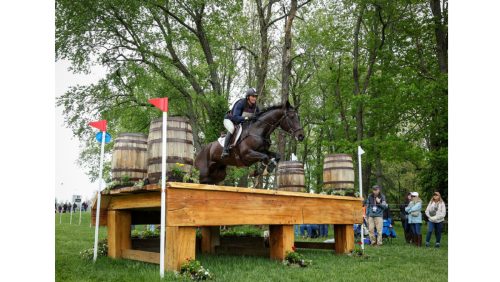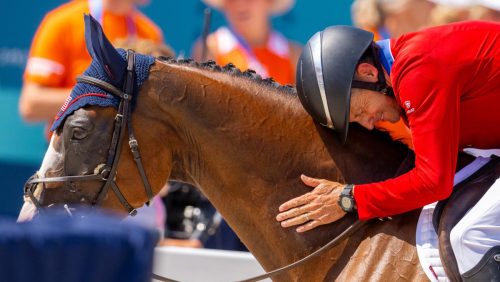Course designer Ruediger Schwarz of Germany has created plenty of challenges for riders in the first World Championship to be held without steeplechase and roads and tracks.
Riders will have several practice areas with different types of fences—both show jumping and cross-country obstacles, as well as a galloping track—to prepare for the task ahead.
Unlike past World Equestrian Games, the course is located across the street from the main competition grounds, and it winds through the beautiful valley farmland of the Aachen Soers.
To begin with, the riders tackle a friendly beginning, with the first fence on a slight uphill rise from the start box, then they gallop slightly downhill to fence 2, a large fallen oak tree set between two trees. Horses then continue around to fence 3, a wagon off a right turn before coming to the first combination at fences 4-5. The two brush fences here are the first question of accuracy, requiring riders to take an angle over both bushes.
These fences are jumped toward the main stadiums, and on landing, riders gallop across the road and into the arena where they did their dressage, jumping two houses on a bending line there (fences 6-7). They come out of the stadium after fence 7, crossing the road again, and go up and over a large bridge that they will later ride underneath near the end of the course. After crossing the bridge, they make a sweeping right turn and approach a coffin combination at fence 8, the Soers Canyon at 8ABC which involves rails, one stride downhill to a ditch and then a stride or two steeply uphill to a narrow brush out.
With the coffin behind them, riders continue onward to a ditch and hedge at fence 9, then to two windmills set atop mounds at fences 10-11, with four or five rolling strides up and downhill between them.
ADVERTISEMENT
The next challenge is the first water complex, the Seaside Resort Soers at fences 12ABCD-13. Riders have to approach the first element, a vertical, on a bending line and make three strides between the log and the drop into the water. It’s then four strides across the water to the bank up and then one stride uphill to a corner of a boat. Horses then run down the mound, back into the water and across to fence 13, a very narrow fence called the Needlemakers Mark (a sign of the traditional needle industries of Aachen). Options do exist here to help riders get around if they have a problem along the way or aren’t willing to risk the difficult bravery and accuracy questions. Riders going for the medals will want to be on their four-minute mark here.
After the water, riders run across the field, jumping the Hay Rack at fence 14 on the way and continue to the Normandy Bank, fence 15ABC. This requires a positive ride to jump up the bank, bounce over a log and then gallop down the mound and over a narrow fence. A very long option exists here, offering riders a chance to jump a separate fence at C, headed back toward the way they came and taking an extra 15 seconds or so.
For the next three fences—a bullfinch, fruit table and fallen tree—riders get into the rhythm of the gallop and prepare for more angles and narrow faces at fence 19AB. Here, they must jump a maximum size hedge, coming slightly uphill, then take five bending strides to an extremely narrow corner, which the horse will only be able to see from two or three strides out. After the corner, they jump a log at fence 20 and are on their way to a gaping trakehner at fence 21. This enormous ditch may convince a horse or two to want to go the alternate route.
The Sunken Meadow, fence 22ABCD, will make riders think quickly, as they jump over a narrow vertical, then a bounce down a narrow bank face into the sunken road, back up onto ground and take two strides to the final element, a brush oxer with another narrow face. Riders keep on to fence 23, the Eifel Village on the Lake, which is a dock to be jumped quickly as they gallop through the water.
The next combination—another question of an angled fence—comes at the Hillock Landscape at fence 24AB. Riders run up the hill, jump over the first at an angle, take two direct strides to the second, then canter back down the hill to a corner off a left turn at the bottom, fence 25.
After a gallop back toward the center of the course, riders tackle fence 26, the Picknick Tables Countryside View, which presents the undulating terrain of a natural stairway on the way to a bench at the top of a hill.
ADVERTISEMENT
After a brief gallop downhill and under the bridge they went over earlier, riders arrive at the other side of the Eifel Village on the Lake, to the challenging water complex at fence 27ABC. The fast route involves a serious angle over the first element, a narrow house, then one stride downhill to a larger house jumped into the lake. It’s likely that many riders will take the longer route here, since the angle is extremely difficult, requiring the stiffest test of boldness and rideability all at once. Once riders land in the water, they turn right and find another house on land, followed by a left turn to yet another house, fence 28.
The final three fences will look quite welcome to riders at this point, as they tackle the Cattle Trough (fence 29), the Night Owl’s Hideway (a keyhole at fence 30) and the final obstacle, set very close to the much-awaited finish.
The ground is already quite wet, and rain is expected for the next two days. While the course is roped off so that only riders walk on the terrain that the horses will need, the footing around the ropes, which has been trampled by spectators, is already a sea of mud. So if the forecast is correct, the weather and footing will almost certainly be an element in this competition.
ABOUT THE DESIGNER
This is the first major championship course designed by Schwarz, 66, of Warendorf. He evented in the 1970s, winning an individual bronze at the 1979 European Championships and a team silver in the 1982 World Championships, where he finished fourth individually.
Schwarz has trained Germany’s pony riders, juniors and young riders. As a course designer, he assisted Capt. Mark Phillips at Achselschwang (Germany) from 1998-2000, and he created the CIC** there. He designs Warendorf and Kreuth in Germany and advises on their three-star events and national championships. For the past two years, he has been technical delegate for the Luhmuehlen CCI**** (Germany).














